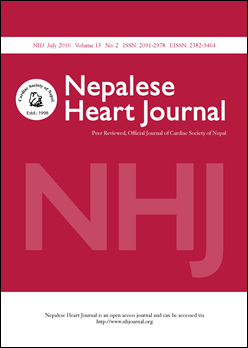Predictors of in-hospital mortality following mitral or double valve replacement for rheumatic heart disease
DOI:
https://doi.org/10.3126/njh.v13i2.15558Abstract
Backgrounds and Aims: Factors affecting outcome of mitral valve replacement in rheumatic population of Nepal is unknown. The aim of this study was to identify the predictors of in-hospital mortality in patients undergoing mitral or double valve replacement in Nepal.
Methods: A retrospective observational study was designed to evaluate the outcome of patients who underwent mitral valve replacement with or without concomitant other valvular surgery during a period of one year in a tertiary care cardiac centre in Nepal. Data were analysed to find the significant predictors of in-hospital mortality.
Results: A total of 411 patients fulfilled the inclusion criteria. The overall in-hospital mortality was 4.1% (95% CI 2.18-6.02). A cutoff value for higher mortality obtained using ROC curve for age was 37.5 years; and for duration of mechanical ventilation was 8.5 hours. Multivariate logistic regression model identified increasing age (>37.5 years), OR 2.05 (95% CI 0.77-5.45), p=0.001; NYHA Class III and IV, OR 15.18 (95%CI 0.9-54.53), p<0.001; presence of left atrial thrombus, OR 4.96 (95% CI 1.49-16.43), p=0.003; tricuspid regurgitation grade III and IV, OR 2.62 (95% CI 0.95-7.24), p=0.004; re-exploration for bleeding, OR 8.62 (95% CI 1.60-46.32), p=0.03; left ventricular ejection fraction (≤40%), OR 8.22 (95% CI 2.62-25.72), p=0.001; inotrope score >20, OR 9.90 (95% CI 3.48-28.15), p<0.001; duration of mechanical ventilation >8.5 hours, OR 22.96 (95% CI 5.15-52.10), p<0.001; and stay in the intensive care unit > 2 days, OR 1.31 (95% CI 0.49-3.46), p<0.001 as predictors of mortality.
Conclusion: Age, NYHA Class, severe tricuspid regurgitation, presence of left atrial clot, re-exploration for bleeding, decreasing left ventricular ejection fraction, high inotrope score, longer duration of mechanical ventilation, and longer stay in the intensive care unit were identified as the independent predictors of in-hospital mortality.
Nepalese Heart Journal 2016; 13(2): 19-24
Downloads
Downloads
Published
How to Cite
Issue
Section
License
This license enables reusers to distribute, remix, adapt, and build upon the material in any medium or format, so long as attribution is given to the creator. The license allows for commercial use.




